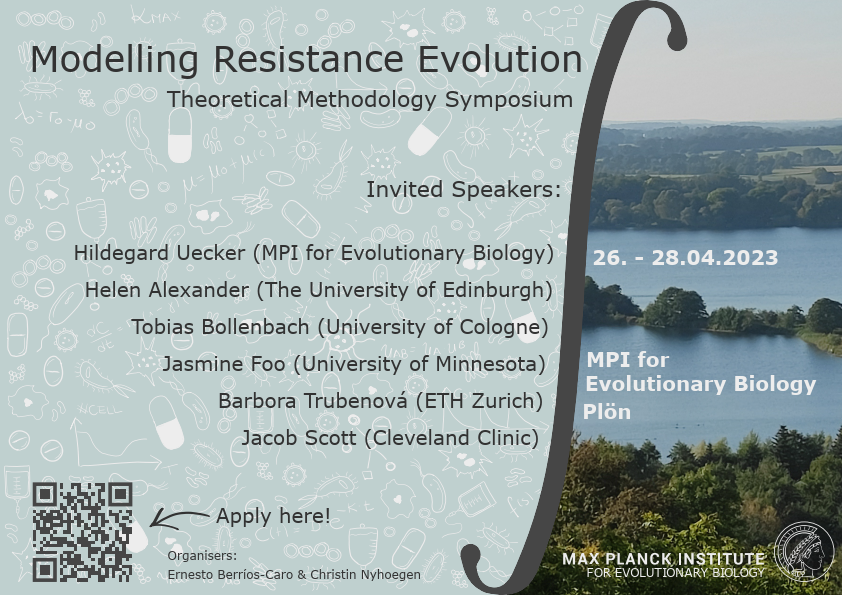Bacterial persistence plays a crucial role in determining the number of surviving cells after antibiotic exposure, thereby having an important effect on the effectiveness of antibiotic treatment. Recent evidence suggests that the persister phenotype may also influence the evolvability of antibiotic resistance. The most common hypothesis to explain this link is that persistence leads to a...
We are interested in modelling Collective antibiotic tolerance (CAT). CAT occurs any time a bacterial population of sufficiently high density survives an antibiotic dose or treatment that a smaller population would succumb to. Various mechanisms have been identified, including cell-to-cell signalling and antibiotic degradation. A known manifestation of CAT is through occurrence of inoculum...
Antibiotic resistance genes are frequently carried on bacterial plasmids. Because plasmids exist in multiple copies in the host bacterial cell, distinct plasmid copies can carry distinct alleles, allowing for heterozygosity not possible for loci on haploid bacterial chromosomes. This plasmid-mediated heterozygosity of antibiotic resistance alleles can produce multidrug resistance, in which a...
Evolution in changing environments is still poorly understood. We analyze a recently introduced and empirically well-grounded model for antibiotic resistance evolution in bacteria [1]. In this model the corresponding fitness landscape changes with the antibiotic concentration, thereby giving rise to tradeoffs between adaptation to low and high antibiotic concentrations. We show that the...
Many pathogenic cellular populations, such as microbial biofilms or solid tumours, are densely packed. However, little is known about how growth-induced collective dynamics - an inherent feature of these systems - reshape the evolution of resistance against antibiotic or anti-cancer therapy. Modelling such emergent phenomena, coupling the mechanical interactions of individual cells to...
Populations of microbial pathogens or cancer cells possess enormous adaptive potential. Such adaptations regularly lead to the failure of treatment, with drastic consequences for individual and public health. From a reductionistic viewpoint, the fundamental processes in such microbial populations are replication, mutation and death. Characterizing these processes by traits allows us to...
To alleviate the threat of antimicrobial resistance (AMR), innovative treatment strategies are urgently needed. The phenomenon of collateral sensitivity (CS) may be exploited to achieve this goal using existing antibiotics. CS occurs when resistance to one antibiotic increases the sensitivity to another antibiotic. CS-based combination treatments could potentially suppress resistance, but it...
The evolution of drug resistance in infectious disease and cancer is a serious threat to public health. The mutant selection window (MSW), defined as the range of drug concentrations that selects for a drug resistant strain, has previously been used as a model to predict and avoid resistance. Under the MSW paradigm, drug regimens should be designed to minimize time spent in the MSW. A...
Plasticity and Genetic Evolution
Mathematical models of cancer and bacterial evolution have generally stemmed from a gene-centric framework, assuming clonal evolution via acquisition of resistance-conferring mutations and selection of their corresponding subpopulations. More recently, the role of phenotypic plasticity has been recognized and models accounting for phenotypic switching...
Development of therapeutic resistance in cancer is typically attributed to natural selection, where a cytotoxic agent eliminates sensitive cells in the population, leaving behind only the resistant ones. However, it appears that non-genetic mechanisms of therapeutic resistance exist as well, and as such they may be reversible through better understanding of underlying biology. Here we discuss...
Recent experiments on the evolution of drug resistance in bacteria have identified a transition from the preferred substitution of high-rate, low-effect mutations to low-rate, high-effect mutations with increasing population size [1]. The greater mutation supply in large populations increases the probability for rare high-effect mutations to arise, which subsequently outcompete the more...
Understanding the evolution of antimicrobial resistance is central for their treatment. In this talk, I want to show a possible way to address this problem from a statistical point of view, namely the hypercubic inference, which we developed and introduced during the last years at the University of Bergen. The basis of this model is a hypercubic transition graph, whose nodes represent possible...
Despite rapid initial responses and low toxicity, targeted therapies commonly fail to provide long-term benefits to cancer patients due to the development of therapy resistance. In multiple solid tumors, this resistance emerges due to gradual, multifactorial adaptation, i.e., a selective process combining genetic and non-genetic methods of cell diversification. This suggests a significant link...
The repeatability of evolution depends strongly on the distribution of fitness effects (DFE) of beneficial mutations. While theoretical modeling has focused mainly on light-tailed DFEs, experiments on antibiotic resistance evolution have also uncovered signatures of heavy-tailed DFEs. We show that in the latter case the repeatability behaves in counter-intuitive ways. Firstly, the evolutionary...

